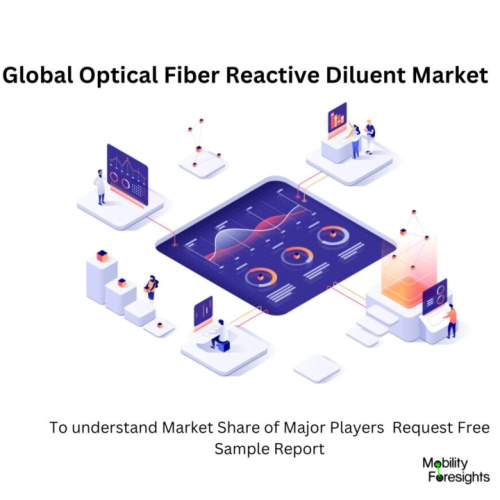
- Get in Touch with Us

Last Updated: Apr 25, 2025 | Study Period: 2024-2030
A reactive diluent is a chemical component that is added to a formulation to change the curing or polymerization properties. Adhesives, coatings, resins, and other polymer-based products frequently contain reactive diluents. They have the ability to improve processability, adjust curing times, and change the mechanical qualities of the finished product.
Optical fibres are the most common type of optical waveguide. Unlike other types of waveguides, optical fibres may be made long and bendable, making them ideal for optical fibre communication transmission media.
Optical fibre reactive diluent is a chemical substance used in the manufacturing and processing of optical fibres. It plays a crucial role in the production of optical fibre coatings and cables. Specifically, a reactive diluent is a compound that is added to the primary resin or polymer material used for coating optical fibres. Its purpose is to modify the viscosity and other rheological properties of the coating material, making it more suitable for the manufacturing process.

The Global optical fibre reactive diluent market accounted for $XX Billion in 2023 and is anticipated to reach $XX Billion by 2030, registering a CAGR of XX% from 2024 to 2030.
In light of their sustainability, low cost, low toxicity, and good performance in the field of UV-LED curable coatings, materials with high bio-content have gradually replaced petroleum-based compounds. Through three phases of amidation, thiol-ene click reaction, and esterification, a new tung oil-based methacrylate (TDMM) with low viscosity and numerous photopolymerizable methacrylates was designed and synthesized.
The reaction conditions for the thiol-ene click reaction were optimized by determining the degree of functionalization of polyols and double bond conversion. 1H NMR and FTIR were used to characterize the chemical structures of the as-prepared TDMM. According to the rheological behaviour investigation, TDMM has a lower viscosity than the petrochemical-based reactive diluent pentaerythritol triacrylate (PETA).
One example of an optical fibre reactive diluent is a monomer called "trimethylolpropane triacrylate" (TMPTA). TMPTA is often used in optical fibre coatings because it can be polymerized, or cross-linked when exposed to UV light. This polymerization process helps create a durable and protective coating around the optical fibre. By adjusting the concentration of TMPTA or similar reactive diluents, manufacturers can fine-tune the viscosity and curing properties of the coating material to meet specific requirements.
| Sl no | Topic |
| 1 | Market Segmentation |
| 2 | Scope of the report |
| 3 | Abbreviations |
| 4 | Research Methodology |
| 5 | Executive Summary |
| 6 | Introduction |
| 7 | Insights from Industry stakeholders |
| 8 | Cost breakdown of Product by sub-components and average profit margin |
| 9 | Disruptive innovation in the Industry |
| 10 | Technology trends in the Industry |
| 11 | Consumer trends in the industry |
| 12 | Recent Production Milestones |
| 13 | Component Manufacturing in US, EU and China |
| 14 | COVID-19 impact on overall market |
| 15 | COVID-19 impact on Production of components |
| 16 | COVID-19 impact on Point of sale |
| 17 | Market Segmentation, Dynamics and Forecast by Geography, 2024-2030 |
| 18 | Market Segmentation, Dynamics and Forecast by Product Type, 2024-2030 |
| 19 | Market Segmentation, Dynamics and Forecast by Application, 2024-2030 |
| 20 | Market Segmentation, Dynamics and Forecast by End use, 2024-2030 |
| 21 | Product installation rate by OEM, 2023 |
| 22 | Incline/Decline in Average B-2-B selling price in past 5 years |
| 23 | Competition from substitute products |
| 24 | Gross margin and average profitability of suppliers |
| 25 | New product development in past 12 months |
| 26 | M&A in past 12 months |
| 27 | Growth strategy of leading players |
| 28 | Market share of vendors, 2023 |
| 29 | Company Profiles |
| 30 | Unmet needs and opportunity for new suppliers |
| 31 | Conclusion |
| 32 | Appendix |